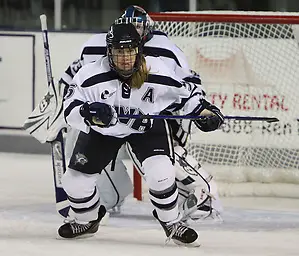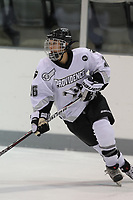Voodoo. Ouija boards. Rabbit’s feet.
Quinnipiac has tried it all this puzzling month of November. The Bobcats are snakebit something bad, as they saw a 35-goal October (eight games) morph into a 13-goal November (seven games).
Coach Rand Pecknold said that the team is just simply frustrated — there’s no other word. You can understand, especially when you consider the Bobcats have outshot their opponent in all 15 games this year. It’s not for lack of trying.
“We generate the chances, but a lot of it is confidence,” said Pecknold. “The big one that got us rolling was when we outshot Clarkson 44-11 and tied 1-1. That shot the locker room confidence.”
As the team’s offense has gone, so has that of October’s ECAC Hockey player of the month Jeremy Langlois. He had eight goals in eight games in October, including a three-game stretch where he scored five (including a hat trick against Canisius on Oct. 15).
Fast forward to November and he’s scored two goals in seven games, those in opposing games at Harvard (Nov. 5) and in the aforementioned Clarkson game on Nov. 11.
He’s currently on an uncharacteristic three-game point- and goal-less streak.
“Frustration would be the key word,” said Pecknold. “These last four games we’ve played well, but we have nothing to show for it. Over those four games, we have two goals on 141 shots.”
Only the Crimson were able to keep the Bobcats under the 30-shot mark in this regular season (Arcadia also did in exhibition play on Oct. 2), giving up just 26 to Quinnipiac. The Bobcats have hit the 40-shot mark four times and poured 51 onto Bentley’s Brandon Komm on Oct. 18. Those were the good old days, considering the Bobcats came away with a 6-1 win.
Somewhere, somebody’s saying, “Well, all those wins came against Atlantic Hockey teams, not ECAC.”
Yeah, many of the wins came against teams from the same league as Sacred Heart, which beat ECAC league leader Yale 7-6; and from the same league as American International, which shut out Brown 3-0, both on Tuesday night. Cornell also barely squeaked out a 1-0 victory against the AHA’s Niagara that same evening.
After the team’s recent 0-2 weekend (including a shutout by Cornell’s Andy Iles — he’s up next), the Bobcats are welcoming a 13-day break from ECAC Hockey play. In the middle of that, they welcome Massachusetts on Friday. The team is also home, where it at least earned a point back on Nov. 11.
“We need to get our confidence back,” Pecknold said. “It is nice to play a non-conference game right now. A couple weeks ago, UMass beat then-No. 1 Boston College, so they’ll be tough, but it will be nice to get home. Eventually, we’ll start getting some breaks.”
That means you, Langlois, and all your buddies — Scott Zurevinski, Matthew Peca and the Jones boys (Kellen and Connor). All you can do is keep shooting — this has got to end eventually with a spinning red light.
“It’s not just ‘Langer,’ all of our forwards are gripping the stick a little bit tight,” Pecknold said. “We need to get our confidence and poise back offensively. We’re rushing the shot a little too much.”
Defensively, the team hasn’t really had problems. The Bobcats have let in 18 goals to 13 scored in ECAC play over seven games, but that’s just 2.57 against per game. Nothing alarming.
“We’ve been better, defensively. We were not very good defensively against Dartmouth,” said Pecknold, referring to a 5-4 loss to the Big Green on Nov. 4. “We’ve made some mistakes. Again, it is frustrating when you’re playing well [and you don’t score].
“We’ve just got to keep plugging away. We’ve got a great group of guys, a great culture here, it’s a fun group to be around,” said Pecknold. “They’re still excited to come to the rink every day. At some point, we’ll turn this around.”
On the spot: Cornell’s Andy Iles
Phew! By talking to Andy Iles on Monday, I’m just pleased as punch that I didn’t jinx his mini-shutout streak. Oops, he did it again on Tuesday, keeping Niagara away from a single goal celebration. Three in a row, and on the day he was named ECAC Hockey goalie of the week to boot.
It was Nov. 12 that the Cornell sophomore last let in a goal. Since then, he’s registered his first three career shutouts in succession, starting last Friday (4-0 win vs. Princeton), Saturday (4-0 win vs. Quinnipiac) and Tuesday (1-0 win vs. Niagara).
He’ll bring this streak into the storied Madison Square Garden in New York on Friday in the Red Hot Hockey game against Boston University.
USCHO.com caught up with Iles between his blankings of the Bobcats and the Purple Eagles.
USCHO: What is the mentality like when you’re in that second shutout, trying to keep up the streak for the good of the team?
Iles: As a goalie, Saturday nights are a little bit easier. Every goalie kind of gets in a rhythm when you’re seeing pucks, so the Saturdays come a little more natural.
USCHO: What kind of demands do you put on yourself in that situation?
Iles: Making sure that as a goalie, you make the saves that you’re supposed to make and come up with some big saves you’re asked to make. That usually translates into team success. The defensemen did a great job of keeping the puck to the outside. [Princeton] had two quality chances here and there that I was able to push aside without any harm.
USCHO: Winning [now five] in a row, what do you think that says about Cornell as a team?
Iles: We’re happy where we are, but at the same time, we know we have a lot of potential on this team. We’re trying to get better every shift, so it’s a process right now. It’s still early in the year. You can’t get complacent or satisfied.
USCHO: What is your perspective on the team’s 1-2 start, with the benefit of hindsight?
Iles: One of the great things about this league is that any night anyone can win. We ran into some tough losses and made some mistakes that were uncharacteristic of our team. We knew, at the same time, we had the potential to be a strong team. We couldn’t get overwhelmed by the losses we had early on, we had to keep our confidence.”
USCHO: Who among your teammates do you see really performing well right now?
Iles: Lots of guys. Guys like Greg Miller and Nick D’Agostino are off to really hot starts, but they’d all agree that what is making us such a good team right now is the supporting cast. Everyone is playing their role. Every team in college hockey has top players, but what separates the good teams from teams that don’t have as much success is the ability of its supporting cast.
Elsewhere around the league
Brown: The Bears suffered their first-ever loss to American International in nine meetings, ending an 8-0-0 winning streak over the Yellow Jackets. AIC’s two goals scored against Brown goalie Mike Clemente (in the 3-0 win) ended Clemente’s personal streak of three games worth of letting up just one goal (resulting in a win, a loss and a tie).
Clarkson: Paul Karpowich tied fellow league goalie Jeff Malcolm (Yale) in placing second in shutouts nationwide with three this season. Also strong defensively for the Golden Knights has been Kevin Tansey, who is plus or even in all 14 games he’s played in this year. The Knights’ upcoming nine-game road string is its longest in 71 years.
Colgate: Player of the week Austin Smith is still on fire, scoring eight points in his last four games. He’s Mr. Momentum as well, scoring two of his three hat trick goals on Friday against Quinnipiac in the final two minutes of each of the first and second periods. He also scored the Raiders’ last hat trick, on March 9, 2009, in the playoffs — also against the Bobcats.
Dartmouth: Coach Bob Gaudet created a bit of a goalie controversy by not starting beleaguered media/coaches preseason goalie of the year James Mello (2.85 goals against average) in either game last weekend. Instead, Jody O’Neill went 1-1-0, with his Friday night start being the first time a goalie other than Mello started for the Big Green. He last started in last year’s Ivy Shootout on Oct. 29-30, 2010, also earning a win and a loss.
Harvard: The Crimson behaved themselves in their Tuesday non-league tilt against New Hampshire, keeping their penalty minutes count under 20 for the first time in five games (six PIM vs. UNH). In their four games between Nov. 11-19, Alex Killorn, Danny Biega, Colin Blackwell and Patrick McNally made it a four-game string of a Harvard player having either a 10-minute misconduct or game misconduct.
Princeton: Not a great weekend for the Tigers, who were outscored 8-1 over Friday and Saturday, with Iles earning a 15-save shutout against Princeton on Friday. Dan Bonar was busy, though, making a career-high 42 saves on 46 shots against Colgate on Saturday in a 4-1 loss. His previous high was 31 saves.
Rensselaer: It’s lonely at the bottom. The Engineers join the soon-to-be-defunct program Alabama-Huntsville in being the only two Division I teams in the country to average less than a goal per game. The Chargers have a 0.83 average, while Rensselaer is at 0.92. The Engineers have been shut out in five of their 12 games.
St. Lawrence: Rookie of the week Chris Martin is one of three Saints freshmen to enjoy a multi-point game this season, with Justin Bruckel joining him in that honor on the same night, Saturday in their 4-3 win over Harvard. Freshman Patrick Doherty had two goals in the 6-5 loss to Rochester Institute of Technology at Blue Cross Arena in Rochester.
Union: Daniel Carr’s four-point game (three goals, assist) was the fourth by an ECAC player this year and the second by a Union player after Wayne Simpson did the same against Army on Oct. 8. Quinnipiac’s Jeremy Langlois (Oct. 15) and Yale’s Kenny Agostino (Nov. 19) have the two other four-point games.
Yale: Bulldogs goalie Jeff Malcolm preceded Cornell’s Iles in putting together a three-game shutout streak, his lasting from Nov. 5 to 12 and extending 226:39, ending in the third period of their 5-3 win over Connecticut on Nov. 19. Iles’ shutout streak is currently at 202:28.
Meeting new recruits
It’s November, so the early signing period is on, and ECAC schools have snatched up some good’uns. Here are three recent “acquisitions” to keep an eye on.
• Matt Buckles (Cornell, 2013-14), Toronto Lakeshore Patriots (OJHL) — Still only 16 with two full seasons to grow, he was praised by his general manager/head coach for his “preparation, consistent compete level, and how he gets along with the boys in the room, being the youngest player on our team.”
• Devon Toews (Quinnipiac, 2013-14), Surrey Eagles (BCHL) — The ’94-born is listed as a defenseman and forward, and had 11 points in 19 games for Surrey this season. He will play in the Western Prospects Junior A challenge this year.
• Kyle Baun (Colgate, 2012-13), Cornwall (CJHL) — Hopefully, he is able to recover quickly from a back injury and keep up the better than point-per-game pace he was on (seven points in six games).
Top three alumni performances
First prize: Joe Nieuwendyk (Cornell), Hockey Hall of Fame — he gave a big shout out to Cornell in his induction speech.
Second prize: Rich Peverley (St. Lawrence), Boston Bruins — He started November with six points in four games and has seven points in his seven games this month.
Third prize: Erik Cole (Clarkson), Montreal Canadiens — After a slow start, he has seven points (out of 12 total) in his last seven games.

